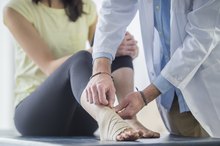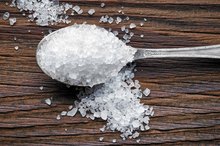How to Reduce Swollen Legs & Feet
Swelling of the legs and feet, also known as edema, occurs when excess fluid gets trapped in the tissues of the lower extremities. Health problems, such as liver, kidney or heart disease, may lead to generalized edema which can impact the legs and feet, while swelling specific to the lower extremities is often caused by poor circulation of blood or body fluids. Sometimes leg swelling can be a sign of a blood clot, or related to a medication side effect or serious malnutrition. While medical management of the underlying condition is essential, most of this swelling can also be improved by some home measures.
If you are experiencing serious medical symptoms, seek emergency treatment immediately.
Understand and Treat the Cause
Swelling happens for a reason, and for effective treatment, the cause has to be addressed. So if your swelling is a new symptom, it's important to alert your doctor and receive and follow your management plan. Treatment may include medications called diuretics, which help flush extra fluid out of your body.
Elevate Your Legs
How to Relieve Ankle Swelling Naturally
Learn More
An effective way to manage lower extremity swelling is to elevate your feet 30 minutes at a time, several times a day. This practice can help this excess fluid flow away from the feet and legs and reduce swelling. It also works best if your feet are above heart level, which can be accomplished by lying down with your feet under a pillow.
Apply Pressure
Swelling from a variety of causes can be improved by compression therapy, which is often accomplished by wearing support or compression stockings. These stockings apply pressure to keep fluid from collecting in your legs and feet. Since compression stockings are available in different pressure levels, ask your doctor which type is right for you. These may be prescribed, or purchased at a drug or medical supply store.
Watch Your Diet
How to Get Rid of Water Retention Fast
Learn More
Sodium is a mineral important in fluid balance, although excess sodium can cause the body to retain water. So if you are prone to swelling, reducing dietary sodium can help. This can be accomplished by eating out less often, limiting processed, canned and boxed foods, and choosing low-sodium seasonings such as fresh herbs and salt-free spices. Staying well hydrated is important too, so most people with edema can drink plenty of water. However, when edema is related to liver, heart or kidney failure, talk to your doctor, as sometimes a fluid restriction is necessary.
Stay Active
Lower extremity swelling can be aggravated by prolonged standing or sitting. If you have to stand for long hours at work, move around so you can shift your weight back and forth and take breaks to rest as able. If you have to sit for extended periods of time, at work or during travel, take short walks or exercise breaks to improve circulation. Leg and foot massage can also ease swelling and improve symptoms 3.
Tips
Check with your doctor before wearing compression stockings, to ensure it's the right therapy for you. For example, compression therapy is generally not recommended in people with peripheral artery disease, a condition which leads to poor blood flow to the limbs.
Warnings
If your swelling is a new symptom, if your existing swelling is getting worse, or if you suspect your swelling is related to a medication side effect, see your doctor. Seek urgent medical attention if your swelling is accompanied by significant pain, shortness of breath, or if the swelling occurred suddenly. Also seek immediate medical care if you have swelling and tenderness in one leg only.
Reviewed by Kay Peck, MPH RD
Related Articles
References
- American Academy of Family Physicians: Edema
- Merck Manual: Edema
- American Family Physician: Edema: Diagnosis and Management
- Medicine Today: A Guide to Peripheral Oedema
- Adukauskiene D, Bivainyte A, Radaviciūte E. Cerebral edema and its treatment. Medicina (Kaunas). 2007;43(2):170-6.
- Cleveland Clinic. Edema.
- Ely, JW, Osheroff JA, Chamblis ML, et al. Approach to Leg Edema of Unclear Etiology. J Am Board Fam Med March 2006, 19 (2) 148-160; DOI: 10.3122/jabfm.19.2.148
- Familydoctor.org. Edema.
- Mayo Clinic. Pulmonary edema.
- Medline Plus. Edema.
- Medline Plus. Pulmonary Edema.
- National Eye Institute. Facts About Macular Edema.
- NCBI Bookshelf. Causes and signs of edema.
- Porter D. What is Macular Edema?
Writer Bio
Rachel Nall began writing in 2003. She is a former managing editor for custom health publications, including physician journals. She has written for The Associated Press and "Jezebel," "Charleston," "Chatter" and "Reach" magazines. Nall is currently pursuing her Bachelor of Science in Nursing at the University of Tennessee.









